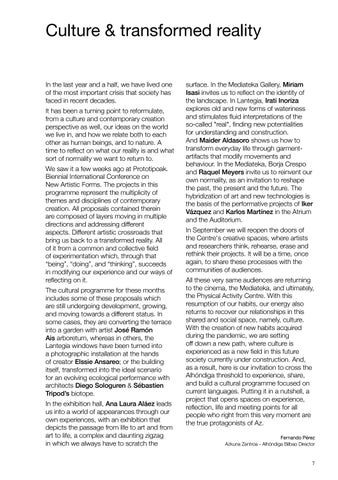Culture & transformed reality In the last year and a half, we have lived one of the most important crisis that society has faced in recent decades. It has been a turning point to reformulate, from a culture and contemporary creation perspective as well, our ideas on the world we live in, and how we relate both to each other as human beings, and to nature. A time to reflect on what our reality is and what sort of normality we want to return to. We saw it a few weeks ago at Prototipoak. Biennial International Conference on New Artistic Forms. The projects in this programme represent the multiplicity of themes and disciplines of contemporary creation. All proposals contained therein are composed of layers moving in multiple directions and addressing different aspects. Different artistic crossroads that bring us back to a transformed reality. All of it from a common and collective field of experimentation which, through that “being”, “doing”, and “thinking”, succeeds in modifying our experience and our ways of reflecting on it. The cultural programme for these months includes some of these proposals which are still undergoing development, growing, and moving towards a different status. In some cases, they are converting the terrace into a garden with artist José Ramón Ais arboretum, whereas in others, the Lantegia windows have been turned into a photographic installation at the hands of creator Elssie Ansareo; or the building itself, transformed into the ideal scenario for an evolving ecological performance with architects Diego Sologuren & Sébastien Tripod’s biotope. In the exhibition hall, Ana Laura Aláez leads us into a world of appearances through our own experiences, with an exhibition that depicts the passage from life to art and from art to life, a complex and daunting zigzag in which we always have to scratch the
surface. In the Mediateka Gallery, Miriam Isasi invites us to reflect on the identity of the landscape. In Lantegia, Irati Inoriza explores old and new forms of wateriness and stimulates fluid interpretations of the so-called "real", finding new potentialities for understanding and construction. And Maider Aldasoro shows us how to transform everyday life through garmentartifacts that modify movements and behaviour. In the Mediateka, Borja Crespo and Raquel Meyers invite us to reinvent our own normality, as an invitation to reshape the past, the present and the future. The hybridization of art and new technologies is the basis of the performative projects of Iker Vázquez and Karlos Martínez in the Atrium and the Auditorium. In September we will reopen the doors of the Centre's creative spaces, where artists and researchers think, rehearse, erase and rethink their projects. It will be a time, once again, to share these processes with the communities of audiences. All these very same audiences are returning to the cinema, the Mediateka, and ultimately, the Physical Activity Centre. With this resumption of our habits, our energy also returns to recover our relationships in this shared and social space, namely, culture. With the creation of new habits acquired during the pandemic, we are setting off down a new path, where culture is experienced as a new field in this future society currently under construction. And, as a result, here is our invitation to cross the Alhóndiga threshold to experience, share, and build a cultural programme focused on current languages. Putting it in a nutshell, a project that opens spaces on experience, reflection, life and meeting points for all people who right from this very moment are the true protagonists of Az. Fernando Pérez Azkuna Zentroa - Alhóndiga Bilbao Director
7





















